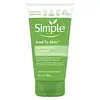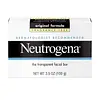What's inside
What's inside
 Key Ingredients
Key Ingredients

 Benefits
Benefits

 Concerns
Concerns

 Ingredients Side-by-side
Ingredients Side-by-side

Water
Skin ConditioningSodium Cocoyl Alaninate
Cocamidopropyl Hydroxysultaine
CleansingDecyl Glucoside
CleansingGlycerin
HumectantPropanediol
SolventGlycol Distearate
EmollientAcrylates/C10-30 Alkyl Acrylate Crosspolymer
Emulsion StabilisingSodium Benzoate
MaskingCocamidopropyl Betaine
CleansingLaureth-4
EmulsifyingCapryloyl Glycine
CleansingUndecylenoyl Glycine
CleansingPanthenol
Skin ConditioningPolyquaternium-39
Tocopheryl Acetate
AntioxidantWater, Sodium Cocoyl Alaninate, Cocamidopropyl Hydroxysultaine, Decyl Glucoside, Glycerin, Propanediol, Glycol Distearate, Acrylates/C10-30 Alkyl Acrylate Crosspolymer, Sodium Benzoate, Cocamidopropyl Betaine, Laureth-4, Capryloyl Glycine, Undecylenoyl Glycine, Panthenol, Polyquaternium-39, Tocopheryl Acetate
Triethanolamine
BufferingTea-Stearate
CleansingGlycerin
HumectantSodium Tallowate
CleansingWater
Skin ConditioningSodium Cocoate
CleansingSodium Ricinoleate
CleansingSodium Oleate
CleansingCocamide Mea
EmulsifyingDisodium Cocoamphodiacetate
CleansingSodium Stearate
CleansingBHT
AntioxidantTocopheryl Acetate
AntioxidantTetrasodium Etidronate
Emulsion StabilisingTrisodium Hedta
Sodium Metabisulfite
Antioxidant
 Reviews
Reviews

Ingredients Explained
These ingredients are found in both products.
Ingredients higher up in an ingredient list are typically present in a larger amount.
Glycerin is already naturally found in your skin. It helps moisturize and protect your skin.
A study from 2016 found glycerin to be more effective as a humectant than AHAs and hyaluronic acid.
As a humectant, it helps the skin stay hydrated by pulling moisture to your skin. The low molecular weight of glycerin allows it to pull moisture into the deeper layers of your skin.
Hydrated skin improves your skin barrier; Your skin barrier helps protect against irritants and bacteria.
Glycerin has also been found to have antimicrobial and antiviral properties. Due to these properties, glycerin is often used in wound and burn treatments.
In cosmetics, glycerin is usually derived from plants such as soybean or palm. However, it can also be sourced from animals, such as tallow or animal fat.
This ingredient is organic, colorless, odorless, and non-toxic.
Glycerin is the name for this ingredient in American English. British English uses Glycerol/Glycerine.
Learn more about GlycerinTocopheryl Acetate is AKA Vitamin E. It is an antioxidant and protects your skin from free radicals. Free radicals damage the skin by breaking down collagen.
One study found using Tocopheryl Acetate with Vitamin C decreased the number of sunburned cells.
Tocopheryl Acetate is commonly found in both skincare and dietary supplements.
Learn more about Tocopheryl AcetateWater. It's the most common cosmetic ingredient of all. You'll usually see it at the top of ingredient lists, meaning that it makes up the largest part of the product.
So why is it so popular? Water most often acts as a solvent - this means that it helps dissolve other ingredients into the formulation.
You'll also recognize water as that liquid we all need to stay alive. If you see this, drink a glass of water. Stay hydrated!
Learn more about Water